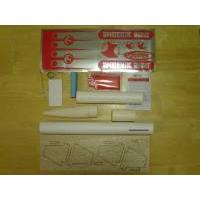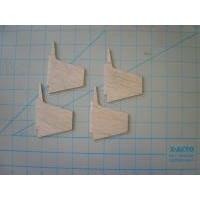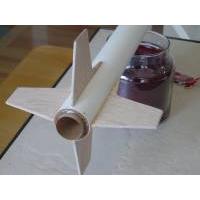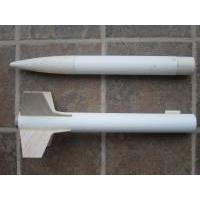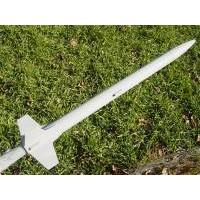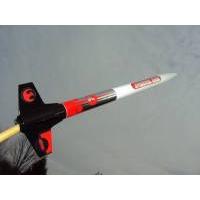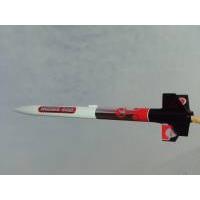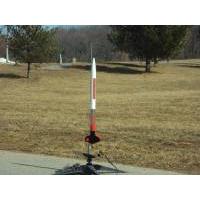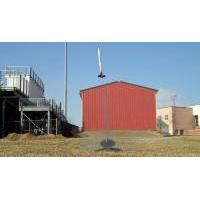| Construction Rating: | starstarstarstarstar_border |
| Flight Rating: | starstarstarstar_borderstar_border |
| Overall Rating: | starstarstarstarstar_border |
| Published: | 2011-02-28 |
| Diameter: | 1.33 inches |
| Length: | 24.00 inches |
| Manufacturer: | Estes  |
| Skill Level: | 1 |
| Style: | Sport |
Brief
The Phoenix Bird is an Estes remake of the early 80s Centuri Phoenix Bird. Although close in appearance, this version uses BT-55 based parts compared to BT-56 used in the original. The biggest difference though is the Estes version uses through-the-tube balsa fins, and a balsa nose cone. The Centuri version used a plastic fin can and plastic nose cone identical to those used on the current Estes Eliminator.
 Components
Components
- Laser cut balsa fins
- Balsa nose cone
- 18 inch red plastic parachute
- Pre slotted body tube
- Payload tube with balsa block
- 18 mm engine mount
- Thick rubber shock cord
- 1/8 inch launch lugs
Construction
This kit goes together easily, but takes a little bit of time assembling the fins and securing them to the engine mount. The most difficult part is completing the two piece balsa fin. The tip of the root edge of the fin gets glued to main portion of the fin. Until the fins are glued to the body, this additional fin piece is easy to snap off. The fins are attached by sliding the tabs on the root edge of the fin through the slotted body tube and gluing them to the engine mount. As Michael Schmid indicates in his review, the directions contain an error in the order which the fins and engine mount are glued to the body. My kit must have been a later production run and included an additional blue direction insert that corrects this error.

The through-the-tube fins provide a rock solid fin unit once glued together. There are only a few other Estes kits that have through-the-tube fin mounting.
Since this kit is relatively heavy (2.8 oz.) and contains a payload section, I opted to install an Estes D/E sized engine mount. I omitted the engine hook and will secure the engines with a wrap of masking tape. In order to accommodate the larger diameter engine mount, I had to trim the tabs on the balsa fins that get glued to the engine mount. I also added 3/16 inch launch lugs since I will be launching with higher thrust D and E engines.
The payload assembly is formed by the upper body tube, a balsa block and the balsa nose cone. The balsa block is glued into the base of the upper body tube and the nose cone is placed on top. A metal screw eye screws into the balsa block, and serves as the connection point for the shock cord. The rubber shock cord is approximately 3/8 inch thick and 18 inches long. I used the trifold method for attaching the rubber shock cord. The trifold pattern printed on the directions appears to be sized for the thinner rubber shock in smaller Estes kits. l made another trifold paper mount that was about 1.5 times the size of orginal mount, and it seemed to glue in the body tube just fine.
Since I plan to launch with an altimeter in the payload bay, I drilled a 1/16 inch hole in the payload section, so that the altimeter can sense external air pressure.
Finishing
 The balsa fins and nose cone require a little extra effort in finishing to fill the balsa grain and get a smooth finish. I shot 3 coats of filler primer sanding in between each coat with 320 grit sandpaper. I then applied a final white coat of primer and sanded with 400 grit paper. This seemed to be enough to fill the balsa grains and the spirals in the body tube. I then applied two coats of Testors white, followed by one coat of black on the fin section. Be sure to follow recoat times on the paint can no matter what brand of paint you use.
The balsa fins and nose cone require a little extra effort in finishing to fill the balsa grain and get a smooth finish. I shot 3 coats of filler primer sanding in between each coat with 320 grit sandpaper. I then applied a final white coat of primer and sanded with 400 grit paper. This seemed to be enough to fill the balsa grains and the spirals in the body tube. I then applied two coats of Testors white, followed by one coat of black on the fin section. Be sure to follow recoat times on the paint can no matter what brand of paint you use.
The decals on this kit look great and are quite flashy, literally. Applying the decals is pretty much a one shot affair. Once you start laying down these stick-on decals they are difficult to pull up and adjust. Be careful when applying the body wrap above the fin section, so that it lines up evenly and all air bubbles are able to be rubbed out.
Construction Score: 4
Flight
My first flight was on a B4-4 per the instructions. I had to use an adapter to fit the 18mm motor in the now larger 24 mm engine mount. I wish I had weighed my rocket before hand or I would not have used the B4-4. After the fact I found my kit weighs 3.5 oz. I also had a Quest altimeter in the payload section, so it was probably pushing 4 ounces not including motor. What was I thinking? The flight on the B4-4 lifted off okay but then proceeded to fly horizontally into a stiff breeze before diving into the ground. The body ejected from the payload section a second or so after impact. Luckily the field was pretty much mud from the recently melted snow. Aside from being stuck a couple inches in the ground there was no damage. The altimeter blinked out 63 feet, ha ha.

Second flight was on a C6-5. The winds were about 10 mph and caused this flight to arc into the wind resulting in altitude of only 289 feet according to the altimeter.
Third flight was on a C11-5. The higher thrust of the C11 sent it up straight and quickly to 415 feet.
I used an Aerotech D15T-7 for the fourth flight. Very fast liftoff. Straight flight to 958 ft. The rocket landed in the parking lot though and is pretty scraped up, but flyable.
Recovery
I tied another rubber shock cord the included shock cord for a total length of about 3 feet. The longer shock cord will reduce the potential for damage from the payload section snapping back into the lower body tube at ejection. I also replaced the Estes pre-assembled plastic parachute with a smaller 12 inch Topfilght nylon chute, to bring it down more quickly on high flights.
Summary
An easy to assemble payload kit with flashy chrome decals. Through-the-tube fin mounting is a plus. The Pheonix Bird is not a high flier on standard Estes A - C size engines, so I chose to install a 24 mm D/E sized mount.
Other Reviews
- Estes Phoenix Bird By Michael Schmid (January 26, 2011)
This is a remake of the old Centauri classic. I was a bit disspointed by Estes' choice not to use the original kit's plastic fin can, nose cone, and body coupler. The instructions for building the kit have a fatal flaw. The kit uses through-the-body-tube fin mounting, and, if the directions are followed, the builder will NOT be able to insert the engine mount as the fin tabs stick well ...
 |
 |
Flights
Sponsored Ads
 |
 |

